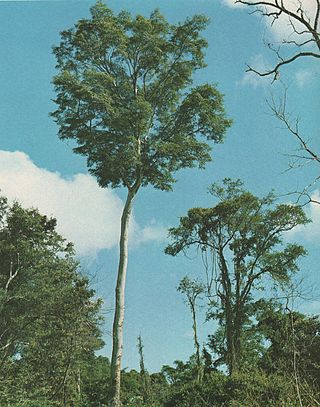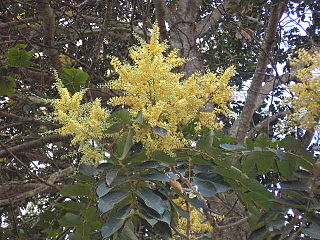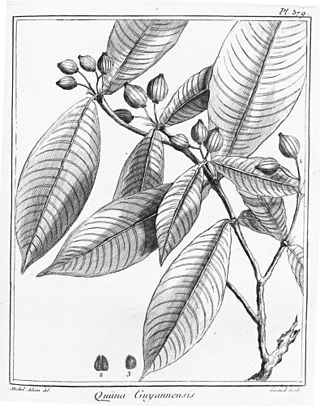
Xylosma is a genus of flowering plants in the family Salicaceae. It contains around 100 species of evergreen shrubs and trees commonly known as brushhollies, xylosmas, or, more ambiguously, "logwoods". The generic name is derived from the Greek words ξύλον (xylon), meaning "wood, tree", and ὀσμή (osmé), meaning "smell", referring to the fragrant wood of some of the species. The Takhtajan system places it in the family Flacourtiaceae, which is considered defunct by the Angiosperm Phylogeny Group.

Antidesma is a genus of tropical plant in the family Phyllanthaceae formally described by Linnaeus in 1753. It is native to tropical Africa, S + E + SE Asia, Australia, and various oceanic islands. The greatest diversity occurs in Southeast Asia.

Pouteria is a genus of flowering trees in the gutta-percha family, Sapotaceae. The genus is widespread throughout the tropical Americas, with outlier species in Cameroon and Malesia. It includes the canistel, the mamey sapote, and the lucuma. Commonly, this genus is known as pouteria trees, or in some cases, eggfruits.

Cynometra is genus of tropical forest trees with a pantropical distribution.
Amburana acreana is a species of legume in the family Fabaceae. It is found in Bolivia, Brazil, and Peru. Its main threat is habitat loss.

Amburana is a genus of legume in the family Fabaceae. It contains three species, which are native to Brazil, Peru, Bolivia, Paraguay, and northwestern Argentina.

Dimorphandra is a genus of legume in the family Fabaceae, subfamily Caesalpinioideae. It includes 26 species native to northern South America, ranging from Colombia and Venezuela to Bolivia, Paraguay, and southeastern Brazil.

Machaerium is a genus of flowering plants in the family Fabaceae, and was recently assigned to the informal monophyletic Dalbergia clade of the Dalbergieae. It contains the following species:

Ormosia is a genus of legumes. 131 living species, mostly trees or large shrubs, are native to the tropical Americas, from southwestern Mexico to Bolivia and southern Brazil, to southern, southeastern, and eastern Asia, and to New Guinea and Queensland. Most are tropical, while some extend into temperate temperate regions of China. A few species are threatened by habitat destruction, while the Hainan ormosia is probably extinct already.

Tachigali is a flowering plant genus in the legume family (Fabaceae). It includes 74 species of trees native to the tropical Americas, ranging from Nicaragua to Bolivia, Paraguay, and southern Brazil. Typical habitats include tropical rain forest, lower montane forest, seasonally-flooded and non-flooded evergreen lowland forest and woodland, gallery and riparian forest, sometimes on white sands, cerrado and other dry woodland, and rocky grassland.
Otoba is a genus of trees in family Myristicaceae that ranges from Nicaragua to Bolivia.
Pouteria oppositifolia is a species of plant in the family Sapotaceae. It is endemic to Brazil. It is threatened by habitat loss.

Quiina is a genus of plant in family Ochnaceae. It contains the following species :
Cenostigma is a genus of flowering plants in the family Fabaceae. It includes 15 species native to the tropical Americas, ranging from Mexico to northwestern Argentina and southern Brazil. It belongs to the subfamily Caesalpinioideae and tribe Caesalpinieae. Cenostigma pluviosa is being investigated as a possible antimalarial medication.
Clathrotropis is a genus of flowering plants in the family Fabaceae. It includes 7 species native to northern South America, ranging from Peru to Colombia, Venezuela, the Guianas, and northern Brazil. The genus belongs to subfamily Faboideae.
Ormosia nobilis is a tree-forming plant species in the genus Ormosia. It grows in tropical South America, primarily in Bolivia, Brazil, Colombia, French Guiana, Guyana, Peru, Paraguay, and Venezuela. The Ormosis nobilis tree is known as "sirari" and it produces a commercial hardwood which is also known as sirari.
Deguelia is a genus of flowering plants in the family Fabaceae. It belongs to the subfamily Faboideae. It includes ten species native to the tropical Americas, ranging from Nicaragua to Bolivia and southeastern Brazil.

Zanthoxyloideae is a subfamily of the family Rutaceae.

Lacunaria crenata is a species of flowering plant in the family Ochnaceae, native from Central America to Brazil. It was first described by Edmond Tulasne in 1849 as Quiina crenata.











